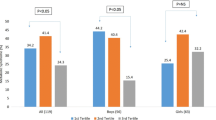Abstract
Assocation of low sex hormone-binding globulin (SHBG) level with the risk of the metabolic syndrome (MetS) in men has previously been reported. A proline to alanine substitution in codon 12 of the peroxisome proliferator activated receptor gamma 2 (PPARγ2) gene has been shown to be related to high insulin sensitivity. The relationship of SHBG levels with the Pro12Ala polymorphism of PPARγ2 in men has not been previously studied. Therefore, we investigated the effect of the Pro12Ala polymorphism of PPARγ2 on SHBG levels in 202 young Finnish men. The range of SHBG was from 3.30 to 73 nmol/L (geometric mean=17.90; 95% Cl=16.62–19.25 nmol/L). Baseline SHBG levels tended to be lower in men who developed the MetS (n=11) compared to men who did not develop the MetS (n=169) (22.85 vs 17.26 nmol/L) on a high-caloric diet during their 6 mo military service. SHBG levels tended to be higher among the subjects with the Al12Ala genotype compared to subjects with the Pro12Pro or Pro12Ala genotypes of the PPARγ gene (27.7 vs 21.7 and 22.7 nmol/L). Among the carriers of the Pro12Pro genotype, those who developed the MetS (n=8) had significantly lower levels of SHBG compared to men who did not develop the MetS (n=93) (13.23 vs 24.22 nmol/L, p=0.027). Among the subjects who developed the MetS those with the Pro12Pro genotype (n=3) had significantly lower levels of SHBG compared to subjects with X12Ala (n=8) (13.23 vs 28 nmol/L, p=0.025). We conclude that the 12Ala allele of PPARγ2, may influence SHBG levels in young Finnish men.
Similar content being viewed by others
References
Pugeat, M., Charles, J., Crave Elmidani, M., et al. (1991). J. Steroid Biochem. Molec. Biol. 40, 841–849.
Laaksonen, D. E., Niskanen, L., Punnonen, K., et al. (2003). Eur. J. Endocrinol. 149, 601–608.
Laaksonen, D. E., Niskanen, L., Punnonen, K., et al. (2004). Diabetes Care 27, 1036–1041.
Muller, M., Grobbee, D. E., den Tonkelaar, I., Lamberts, S. W., and van der Schouw, Y. T. (2005). J. Endocrinol Metab. 90, 2618–2623.
Alberti, K. G., Zimmet, P., and Shaw, J. (2005). Lancet 366, 1059–1062.
Mousavinasab, F., Tahtinen, T., Jokelainen, J., et al. (2005). Endocrine 26, 65–69.
Mousavinasab, F., Tahtinen, T., Jokelainen, J., et al. (2005). Endocrine 27, 307–310.
Berger, J. and Moller, D. E. (2002). Ann. Rev. Med. 53, 409–435.
Spiegelman, B. M. (1998). Diabetes 47, 507–514.
Deeb, S. S., Fajas, L., Nemoto, M., et al. (1998). Nat. Genet. 20, 284–287.
Loi, C. M., Stern, R., Koup, J. R., Vassos, A. B., Knowlton, P., and Sedman, A. J. (1999). J. Clin. Pharmacol. 39, 410–417.
Tarkun, I., Cetinarslan, B., Turemen, E., Sahin, T., Canturk, Z., and Komsuoglu, B. (2005). Eur. J. Endocrinol. 153, 115–121.
Sepilian, V. and Nagamani, M. (2005). J. Clin. Endocrinol. Metab. 90, 60–65.
Cataldo, N. A., Abbasi, F., McLaughlin, T. L., et al. (2005). Hum. Reprod. 21, 1–12.
Tähtinen, T. M., Vanhala, M. J., Oikarinen, J., and Keinänen Kiukaanniemi, S. M. (1998). J. Cardiovasc. Risk 5, 319–323.
Tähtinen, T. M., Vanhala, M. J., Oikarinen, J., and Keinänen Kiukaanniemi, S. M. (2001). Ann. Med. Fenn. 76, 239–246.
Katz, A., Nambi, S. S., Mather, K., et al. (2000). J. Clin. Endocrinol. Metab. 85, 2402–2410.
Plymate, S. R., Matej, L. A., Jones, R. E., and Friedl, K. E. (1998). J. Clin. Endocrinol. Metab. 67, 460–464.
Kadowaki, T. (2005). Endocrinology 146, 3263–3265.
Panidis, D., Kourtis, A., Farmakiotis, D., Mouslech, T., Rousso D., and Kolikos, G. (2003). Hum. Reprod. 18, 1790–1796.
Allen, S. (2005). J. Urol. 174, 1045–1046.
Author information
Authors and Affiliations
Corresponding author
Rights and permissions
About this article
Cite this article
Mousavinasab, F., Tähtinen, T., Jokelainen, J. et al. The Pro12Ala polymorphism of the PPAR gamma 2 gene influences sex hormone-binding globulin level and its relationship to the development of the metabolic syndrome in young finnish men. Endocr 30, 185–190 (2006). https://doi.org/10.1385/ENDO:30:2:185
Received:
Revised:
Accepted:
Issue Date:
DOI: https://doi.org/10.1385/ENDO:30:2:185




